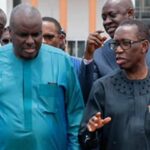
The Chief Executive Officer of Ikeja Electric Plc, Folake Soetan, in this interview with OPEOLUWANI AKINTAYO, opens up on some of the power sector challenges
The IKEDC had a challenge of N70bn debts owed by customers and MDAs in August 2021. Have you been able to recover the money?
The emphasis has shifted from debts to some other things. The business is in stages. For instance, in 2016/2017, we had issues with customers asking us to come and take our lines due to a low supply. The challenge we had then was that we didn’t have supply and customers were frustrated and kept clamouring for supply. Then, there was a phase when we started having supplies, and the challenge of customers complaining of estimated billing, while DisCos complained of inappropriate pricing. That was when the issue of shortfalls and debts came in. So, we decided on how to recover the shortfalls. Ministries, Department and Agencies still owe us and that was when Fashola was the minister. He asked us to compile a list of debtors as they were going to manage it. From there, we started doing bilateral power, then we started Metering Assets Providers, MAPs. The MAPs came, and it took a long time to work due to teething problems. We had the issue of dollar fluctuation; forex was high that even to clear the equipment at the port was a problem. So, MAPs didn’t take off until much later. Then, COVID-19 came. During COVID-19, there was an improved power supply, but MAPs was slow. That was when the government introduced the service-based tariffs – to make customers begin to pay according to how much electricity they consumed. But before that time, we had already started the bilateral power which was becoming very successful, especially with people at Magodo (Lagos) as they started experiencing 24 hours supply. Ikeja GRA too keyed into the bilateral power. In September 2020, there was clamour against the service-based tariffs from the organised labour and other parties, and that was when the government said it should be suspended and redesigned. In November 2020, the government came with revised tariffs. That was when the National Mass Metering Programme was introduced to cushion the effects of the tariffs. The metering programme was not based on affluence because it is what you use that will reflect on your meter.
Now, customers are sometimes confused between MAPs and the Federal Government’s free metering programme. Consumers think meters are supposed to be free.
It’s just the Federal Government’s meters that are free. The ones under MAPs are not free. Why would someone say DisCos are going to distribute meters for free without cancelling the MAPs? What we were told is that we should keep selling meters via MAPs. Government also knows that people are willing to pay for meters. No matter what you read on the pages of newspapers, if we don’t see any letter from NERC or the Federal Government, the DisCos won’t do anything about it. We act based on whatever we are told officially.
What the DisCos and the NERC told journalists when MAPs was about to commence was that customers who bought meters would be refunded with electricity units. But as we speak, electricity consumers are yet to be refunded. What is going on?
For the record, we are not aware of any such arrangement. There are no modalities towards refunding anybody. But what we can’t say is if NERC has such in the pipeline.
But providing meters is solely the responsibility of DisCos because they are your properties.
What we are saying is that meters are available for those who want to buy. We are not compelling anyone to buy meters under the MAPs. The NERC could have approached DisCos so that modalities would be reached if they wanted those who bought to be refunded. Ikeja Electric has never come out to say we would refund customers who buy meters under MAPs. Whether it is going to happen, we are not aware. Whatever is going to happen will be documented and sent to us and we follow it up. This statement was made as at the time MAPs was launched. As at that time, no one knew they would launch the mass metering programme. At that time, there were stories in the newspapers that nobody should buy meters again. That statement was made by a politician vying for a post then. I don’t want to mention names. He was practically saying MAPs was dead and that consumers should wait for free meters from the NMMP. But the free metering was stopped after the first round, and MAPs was brought back. We need to be careful. Let NERC write to us that we should not sell meters again, then, we will stop it.
How do you measure the health of a DisCo?
One of the ways is through the AT&T losses. The lower the losses, the more robust the business is. Have you ever noticed that no DisCo in Nigeria is appraised based on customer relations? No, because that’s not the parameter to measure the resources of a DisCo. A DisCo may be the best at managing customer issues but the other basic parameters that will make sure it remains sustainable, if low, will make the DisCo go down. Those DisCos that had challenges had those issues because of their book balances. They could not sustain their operations. The truth is that customers have their reality; the government has its reality; and NERC also has its own reality. If the government, for instance, is looking for foreign investments, it is the health of the business they will look at. So, if a DisCos is not healthy, who will invest in it? So, I think it is important when we are measuring because I see people applauding when DisCos were being taken over.
The regime that we have now is such that everyone is expected to live up to their responsibilities because we have signed contracts. The nation is tired of embarrassment. That’s why people are even saying we should at least sustain the 5000MW that we have first. So, what regulator measures us with is different from what customers are thinking. So, when you see us chasing some certain things, it’s not because we don’t have customers in mind. Our slogan is ‘customers first’ but it may not translate to immediate change, but ultimately, there will be changes that they want to see. Now, everybody in Magodo is an evangelist of Ikeja Electric, whereas three or four years ago, Magodo residents did not even want to have anything to do with us. They almost spat on our faces when we went there. Our idea is to make sure that the whole of our network is like Magodo where residents enjoy 24 hours steady electricity.
Have the DisCos signed the gas contract spoken by the NERC in view of the 5000MW target?
What you need to understand is that we should not generalise DisCos. We have individual and unique identities. It’s not our responsibility to deliver 5000MW.
The NERC said while GenCos must deliver 5000MW, DisCos must take all, and any defaulting party would be penalised.
The 5000MW is not enough to cover the whole of Nigeria. It is not even enough for the DisCos. What they are generating now, how many megawatts go to each DisCo that we won’t be able to take? It is when they are able to generate 10,000 or 15,000 megawatts, and where they will be asking Ikeja Electric to pick 2000MW then, we would say we don’t have the capacity to take all. Our current infrastructure is capable of picking whatever they give us. How much are they even giving us daily? Ikeja Electric takes the highest, and it’s 15 per cent of whatever is being generated, between 400-500MW daily. And it’s not every day we get that. I have been shying away from putting figures to the kind of investments we make on our network.
Is it true that whatever bill is not collected from pre-paid meter users is shared to those on estimated billing even when those areas did not enjoy stable electricity?
In those days, what used to happen was people complaining about arbitrary bills. The first step was for us to meter the transformers to know how much came in from there. After metering them, we see whatever was consumed by all the areas under our network. And based on different parameters, we would make our calculations. In that case, we now look at the prepaid meters and see what was consumed. Based on the parameters we have put there then, we adopted a calculation called ‘daily methodology’ to address the matter. After a while, people still complained that it was not working. What people don’t understand is that when they say they are paying excessively, someone in the three bedroom uses a gas cylinder. Someone in one bedroom uses an electric cooker bought from Lawanson. Those things are 10 years old. The more modern they are, the less electricity they consume. So, the NERC introduced capping and we were asked to remove our billing methodology. Based on certain parameters mostly on availability of electricity, we can’t charge them more than a certain amount. So, some people in certain areas are on capping, but their bill is high because of the availability of power supply. Don’t forget that the guy using a prepaid meter is more careful in managing his light than those without prepaid meters.
What is the fate of consumers who invest in transformers?
It is our responsibility to do all that for customers. But the issue is that we all know the challenges of the power sector and even other sectors that everything can’t be done at a time. Some people request for poles; some request for aluminium conductors; and some request meters. What is the essence of government intervention? It’s because they know that DisCos cannot fund everything alone. That is why we keep telling those that want to invest in our networks that we are the ones that should be responsible for them. But some will tell us that they can’t wait until we are able to reach them, which is why you see some communities coming to say they would do some things by themselves. Then, we will ask them to commit themselves in a letter that they were the ones that offered to do those things willingly. It’s just like the metering we are talking about. It’s because some people cannot wait for free meters that NERC said we should allow willing customers to purchase their meters. It’s not as if we are not doing anything. As you were coming in, I am sure you saw a big transformer outside that we just brought in, it’s a giant transformer just like the one used in installing injection boxes.





